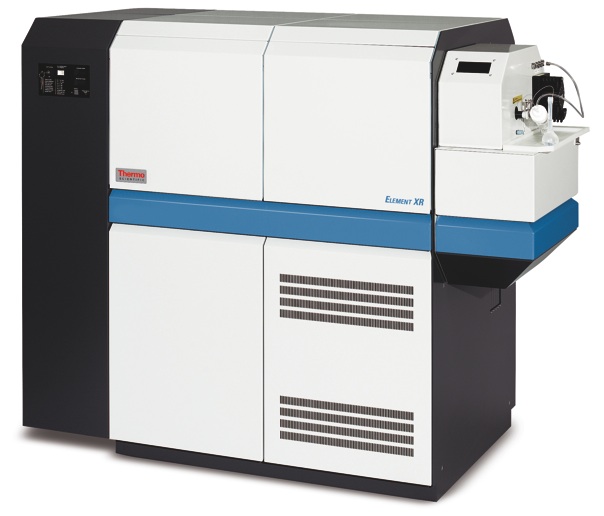ICP-SFMS
ICP-SFMS
Double focusing (electric and magnetic) ICP-MS, also called Sector Field (ICP-SFMS), is the premier type of ICP-MS for trace and ultra-trace element determinations because it provides the lowest detection limits of any ICP-MS due to its high sensitivity and low background. With resolving power (m/Δm) of ~10,000, it is also capable of unambiguously separating many of the common isobaric interferences. Due to flat-topped peaks, ICP-SFMS produces more precise isotope ratio data than conventional quadrupole-based ICP-MS, although multiple collector (MC) instruments are needed for truly high precision ratio measurements. Our laboratory features the Element XR from Thermo Scientific. Below is some information on its capabilities. Additional details are provided via the brochure link on this page.
Variable Resolution using the Element XR ICP-SFMS
The unequivocal separation of analyte ions from spectral interferences is a prerequisite of accurate and precise analysis. High mass resolution is the universal means for this separation. Spectral interferences are the main limitation of ICP-MS. The argon plasma gas, water, acid and the sample matrix itself can combine to introduce a wide range of polyatomic ion species. The resultant interfering species may have the same nominal mass as an analyte ion and thus return a falsely high value for the analyte. Numerous strategies have been used in order to try to minimize or circumvent the formation of these spectral interferences. These include mathematical corrections, special sample introduction systems, special plasma parameters and collision/dynamic reaction cells to neutralize part of the interferences. High resolution with a sector-field mass spectrometer simply distinguishes the analyte from interference by difference in mass. The capability of high mass resolution is a feature unique to the ELEMENT 2/XR product lines. This ability can be used for quantification and isotope ratio analysis for nearly the whole periodic table, and in almost all matrices.
Low Resolution
Low resolution (R ~ 300) is used for the analysis of non-interfered isotopes. In this mode the ELEMENT XR’s sensitivity is the highest of all commercially available ICPMS instruments. Additionally, the flat top peak shape is an advantage for high precision isotope ratio measurements.
Medium Resolution
Medium resolution (R ~ 4000) guarantees interference-free analysis for most elements in the majority of sample matrices. For example, transition elements are routinely measured in medium resolution due to the formation of many interfering polyatomic species in the mass range 24 – 70 μ.
High Resolution
High resolution (R ~ 10000) is used for the analysis of elements in the most challenging sample matrices. For example, high resolution is used to separate As and Se from argon dimer interferences and argon chloride interferences in chlorine matrices, heavy rare earth elements from light rare earth element oxides in geological matrices, platinum group elements from argon-transition metal molecular species, and/or the oxides of Hf, Ta and W.
Extending the Linear Dynamic Range
The most recent high resolution ICP-MS, the Thermo Scientific ELEMENT XR, opens another dimension of linearity in ICP-MS. Incorporating a single Faraday detector in addition to the discrete dynode detector offers > 12 orders of magnitude linear dynamic range. Herewith the dream of analyzing ultra-trace elements and matrix elements within the same analysis becomes true! Extremely short integration times of < 1 ms in analog and Faraday mode, and 0.1 ms in counting mode in combination with a switching time of 1 ms between analog and faraday mode, makes the ELEMENT XR the perfect tool for transient signals such as those from laser ablation.
